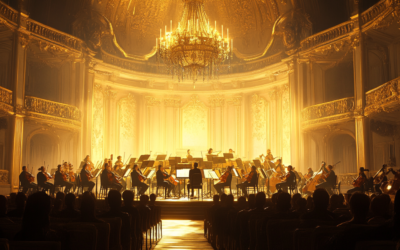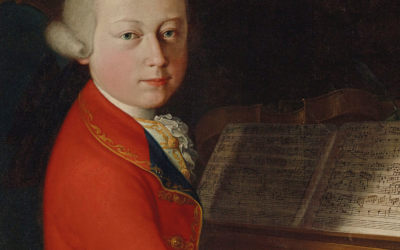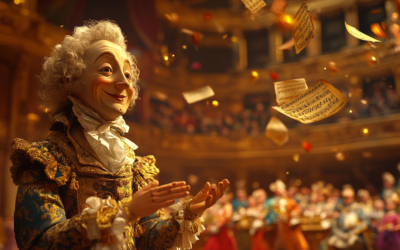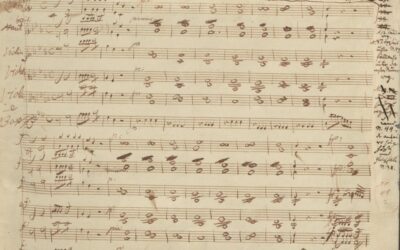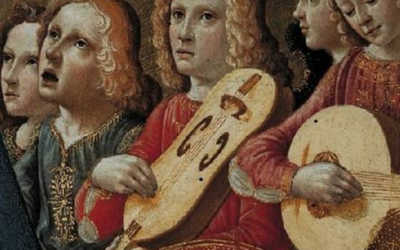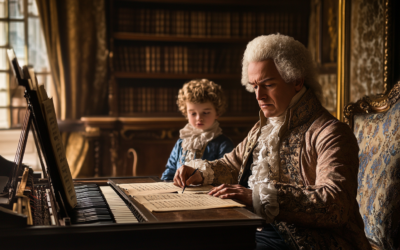The Violin Concertos
Unveiling the Borrowed Brilliance Behind Mozart’s Works
Mozart’s violin concertos have long been hailed as some of the greatest compositions in classical music. However, a closer examination reveals that they may not be as original as often claimed. The concertos showcase a brilliant synthesis of existing musical material rather than purely novel creations. Evidence suggests that Mozart might have drawn heavily from earlier sources, even leaving fragments of his work unfinished and relying on others to complete them.
This article explores the history, controversies, and misattributions surrounding these concertos, particularly the unfinished Violin and Piano Concerto K.Anh.56 K6 315f. We also delve into the stories behind the lesser-known sixth and seventh violin concertos, examining how bias and preconceived notions have led to decades of confusion and debate about their authenticity. Are these truly Mozart’s works, or do they reflect a more complex narrative of influence and adaptation?
Mozart: The Fall of the Gods
This book compiles the results of our studies on 18th-century music and Mozart, who has been revered for over two centuries as a deity. We dismantle the baseless cult of Mozart and strip away the clichés that falsely present him as a natural genius, revealing the contradictions in conventional biographies. In this work, divided into two parts, we identify and critically analyze several contradictory points in the vast Mozart bibliography. Each of the nearly 2,000 citations is meticulously sourced, allowing readers to verify the findings. This critical biography of Mozart emerges from these premises, addressing the numerous doubts raised by researchers.
"The fact that the first 74 bars are already prepared for real performance suggests that Mozart was copying from an original source that has since been lost."
Mozart: The Fall of the Gods
Mozart’s Violin Concertos: A Blend of Existing Material
Mozart’s violin concertos are often celebrated as brilliant works, yet there is little in them that is genuinely “new.” Instead, they demonstrate a clever combination of existing compositional material, often adapted to fit his own needs.
The Unfinished Violin and Piano Concerto
Take, for instance, the autograph of the fragmentary Violin and Piano Concerto K.Anh.56 K6 315f, dated Mannheim 1778. In his letter of November 12 of that year, Mozart informed his father about an upcoming amateur academy in Mannheim, modeled after those in Paris. Violinist Ignaz Franzl was to perform as the lead, and Mozart likely envisioned himself as the pianist for this new concerto. However, despite starting the composition, he abandoned the project. Musicologist Alfred Einstein speculated that the court orchestra moved to Munich, rendering the concerto unnecessary, but this event had occurred months earlier and was unrelated to the amateur academy Mozart described. The reason why the concerto remained unfinished remains a mystery. Mozart left Mannheim in early December, never returning to complete it.
Of this unfinished concerto, only 120 bars of the first movement survive, with just the first 74 fully orchestrated and marked with dynamics such as staccato and dynamic instructions like “piano” and “forte” — details added to a finalized work. From bar 75 onward, the orchestral parts are missing entirely. The fact that the first 74 bars are prepared for real performance suggests that Mozart was copying from an original source that has since been lost. Despite its fragmentary nature, the concerto has been completed, recorded, and presented worldwide under Mozart’s name, even though much of the music is fabricated.
Controversies and Misattributions: The Case of K.268
Mozart is credited with seven violin concertos, but only five are reliably attributed to him:
- K.207 in B-flat major, Salzburg (?) April 1775 (1780?).
- K.211 in D major, Salzburg, June 14, 1775 (1780?).
- K.216 in G major, Salzburg, September 12, 1775 (1780?).
- K.218 in D major, Salzburg, (?) October 1775 (1780?).
- K.219 in A major, Salzburg, December 20, 1775 (1780?).
These were supposedly completed in 1775, except for K.207, which some sources date back to 1773. However, neither Leopold nor Wolfgang mentioned these concertos in any of the twelve letters from 1775. In his letter of October 6, 1775, to publisher Johann Gottlob Immanuel Breitkopf in Leipzig, Leopold fails to mention them, even though he could have proposed them for publication.
There are also a sixth and seventh violin concerto, the so-called Kolb Concerto. The sixth, in E-flat major K.268, faced controversy simply for being poorly composed. While some claimed it was genuine, others considered it fake or only partially authentic. Despite no clear reason to differentiate it from Mozart’s other violin concertos, it was relegated to the spurious section of the K6 catalogue due to its musical flaws. Some speculate that Johann Friedrich Eck might be the true composer, but no concerto of his matches this one, as they are all of superior quality.
The controversy over K.268 highlights how attributions can be distorted by bias. Publisher André first issued the concerto in 1799 as Mozart’s work. The Allgemeine Musikalische Zeitung quickly dismissed it as an imposture, containing “elementary offenses against the rules of composition.” However, in January 1800, the same journal defended the work, claiming that Mozart wrote it 15 years earlier, based on testimony from violinist Johann Friedrich Eck. According to Eck, Mozart had presented the concerto as his own work in Munich.
Constanze Mozart remained silent, perhaps preferring to exclude the poorly crafted piece from Nissen’s 1828 biography. Similarly, the concerto was absent from Jahn’s 1859 biography. Köchel, however, included it in his 1864 catalogue as K.268, assigning it to 1776 and declaring it authentic. Breitkopf’s 1882 editions reconsidered and placed it among spurious pieces, commenting that K.268, in its present form, could not be by Mozart due to its objectively unpleasant sections. Nevertheless, they conceded that the few “beautiful” parts must be Mozart’s.
Mozart’s supposed genius couldn’t possibly fail, so later scholars like Abert suggested that Mozart only sketched the outer movements, leaving the inept Süssmayr to complete them. George De Saint-Foix supported this view, asserting that only the orchestral tutti and a few violin solos were authentic. He dated the concerto to 1784 or 1785, aligning with the Allgemeine Musikalische Zeitung’s earlier statement.
Over the years, speculation grew. In 1931, Cecil Bernard Oldman identified similarities with the Sinfonia Concertante K.364 and suggested that K.268 was composed in Munich or Salzburg between 1779 and 1781. Eventually, Alfred Einstein moved the concerto in his K3 catalogue to K.365b, proposing that Mozart only sketched the first movement and perhaps a few successful measures of the rondo, while the central movement was likely a fake.
Friedrich Blume, in 1956, argued for the concerto’s full authenticity, claiming Mozart wrote it between 1777 and 1783, refining only the violin parts and leaving other sections unfinished. He suggested that André might have commissioned someone else, unskilled in composition, to complete it. The K6 catalogue, reflecting the advanced Mozart studies of the time, accepted Blume’s theory and placed the concerto in the spurious section Anh.C 14.04 in 1964.
However, the saga of the sixth concerto did not end there. In 1978, Walter Lebermann claimed Eck wrote the concerto, while Robbins Landon noted in 1988 that Mozart could not have composed it before 1783, as it included a passage plagiarised from Haydn’s Symphony No. 77.
You May Also Like
Rediscovering Musical Roots: The World Premiere of Gasparini and Mysliveček
This December, history will come alive as the Camerata Rousseau unveils forgotten treasures by Quirino Gasparini and Josef Mysliveček. These premieres not only celebrate their artistry but also reveal the untold influence of Gasparini on Mozart’s Mitridate re di Ponto. A pivotal event for anyone passionate about rediscovering music history.
The Curious Case of Mozart’s Phantom Sonata
In a striking case of artistic misattribution, the Musikwissenschaft has rediscovered Mozart through a portrait, attributing a dubious composition to him based solely on a score’s presence. One has to wonder: is this music really Mozart’s, or just a figment of our collective imagination?
The Illusion of Canonic Mastery
This post explores the simplistic nature of Mozart’s Kyrie K.89, revealing the truth behind his early canonic compositions and their implications on his perceived genius.
The Unveiling of Symphony K.16
The Symphony No. 1 in E-flat major, K.16, attributed to young Wolfgang Mozart, reveals the complex truth behind his early compositions. Far from the prodigious work of an eight-year-old, it is instead a product of substantial parental intervention and musical simplification.
The Cibavit eos and Mozart’s Deceptive Legacy
The Cibavit eos serves as a striking reminder that Mozart’s legacy may be built on shaky foundations, questioning the very essence of his so-called genius.
K.143: A Recitative and Aria in the Shadows of Doubt
K.143 is a prime example of how Mozart scholarship has turned uncertainty into myth. With no definitive evidence of authorship, date, or purpose, this uninspired recitative and aria in G major likely originated elsewhere. Is it time to admit this is not Mozart’s work at all?


